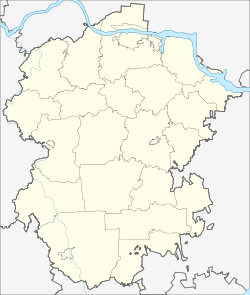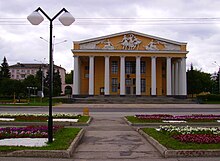Cheboksary
city
|
||||||||||||||||||||||||||||||||||||||||||
|
||||||||||||||||||||||||||||||||||||||||||
|
||||||||||||||||||||||||||||||||||||||||||
| List of cities in Russia | ||||||||||||||||||||||||||||||||||||||||||
Cheboksary ( Russian Чебокса́ры , Chuvash Шупашкар / Şupaşkar ) is the capital of the Russian Federal Republic of Chuvashia in the Volga federal district . It is the most important industrial location and cultural center of the republic.
The place has been attested as a settlement since the 15th century and has 453,721 inhabitants (as of October 14, 2010).
geography
Cheboksary is located in the east of the Russian plain 668 km from Moscow , on the right bank of the Volga between the tributaries Sura and Swijaga.
City structure:
The city of Cheboksary is divided into three administrative districts:
- the Kalinin district to the east
- the Lenin district in the south
- the Moscow district in the northwest
- In addition, the places Novyje Lapsary, Sosnowka, Possjolok Severny and Chandrovo belong to the area of the city.
On March 2, 2008, at the same time as the presidential elections, a referendum on the unification of the two cities took place in Cheboksary and Novocheboksarsk . This plan failed, however, as 63% of the citizens of Cheboksary voted in favor, but only 38% of the residents of Novocheboksarsk.
climate
The city is located in the temperate continental climate zone . The weather in Cheboksary is also heavily influenced by the Volga. In the city center and in the northern parts of the city in particular, it is windier and a little cooler than in the rest of the city. In general, the wind blows weak to moderate from the south or west, in summer from the north-west. Summers are generally warm to hot and winters are generally cold. Temperatures often rise above 30 ° C in July and August, plus an average annual humidity of 75%. In January and February the values can drop to below −30 ° C. The mean annual rainfall is 554 mm . The warmest month is July with an average of 18.8 ° C and the coldest is January with an average of −12.9 ° C. Most of the precipitation falls in July with an average of 71 millimeters, the least in February and March with 24 mm. At the end of winter there is 30 to 40 cm of snow. The lowest temperature ever measured was −46.8 ° C in January 1942 and the highest was 37.9 ° C in July 1971.
| Cheboksary | ||||||||||||||||||||||||||||||||||||||||||||||||
|---|---|---|---|---|---|---|---|---|---|---|---|---|---|---|---|---|---|---|---|---|---|---|---|---|---|---|---|---|---|---|---|---|---|---|---|---|---|---|---|---|---|---|---|---|---|---|---|---|
| Climate diagram | ||||||||||||||||||||||||||||||||||||||||||||||||
| ||||||||||||||||||||||||||||||||||||||||||||||||
|
Monthly average temperatures and rainfall for Cheboksary
Source: Roshydromet
|
|||||||||||||||||||||||||||||||||||||||||||||||||||||||||||||||||||||||||||||||||||||||||||||||||||||||||
Population development
| year | Residents |
|---|---|
| 1897 | 4,738 |
| 1939 | 30,996 |
| 1959 | 104,374 |
| 1970 | 216.139 |
| 1979 | 307,599 |
| 1989 | 419,592 |
| 2002 | 440.621 |
| 2010 | 453.721 |
Note: census data
economy
The main industries are mechanical engineering and metal processing, chemistry, light industry, food industry, forestry, wood processing and construction industry. The Traktornye Sawody Holding is based in Cheboksary. About 13 kilometers downstream from the city center is the dam of the 2,274 km² Cheboksarsk reservoir with a hydropower plant with an installed capacity of 1404 megawatts.
traffic
Cheboksary is directly connected to the two Russian highways M7 Volga and R176 Vyatka . In addition, the "Чувашия" train runs regularly from the Kazan train station in Moscow to Cheboksary. There is also a connection to Kanasch and Kazan . Most of the local public transport is covered by the trolleybus network. There are also 16 bus routes and 35 Marshrutka routes within the city . There are also marshrutkas that connect Novocheboksarsk and the surrounding villages with the capital. The fare in the overland marshrutkas depends on the length of the route. There is also an airport 7 km southeast of the city with regular connections to Moscow-Domodedovo . Not far from the center is the tourist port of Cheboksary. As long as the Volga is still ice-free, tourist ships dock there. A passenger ferry runs only in summer and connects the city with the beaches on the other side of the Volga.
Culture
Museums
The Chuvash National Museum, located on the Salif, is the largest museum in the city and shows, in addition to the history of the region from the Ice Age to the time of the Soviet Union, the native fauna and gives an insight into the Chuvash culture. There are still two museums in the center of Cheboksary: the geological museum and the beer museum, which reopened in January 2009. A museum with the original log house in which he lived is dedicated to the Russian revolutionary leader Vasily Tschapajew , who lived in Cheboksary for a time. Almost 20,000 graphics and sculptures by local and foreign artists are exhibited in the Chuvash Art Museum. There are also constantly changing exhibitions. There are also the following museums in the city: House for Chuvash Folk Art, Ivanov Literature Museum, Sespel Literature Museum, Forest Museum and some galleries, such as the art gallery on the Volga.
Libraries
In the city is the Chuvash National Library with over 2 million media units, 40,000 of which are books in the Chuvash language. Its history goes back to 1870. Two other larger libraries are the central city library of Cheboksary and the scientific library of the Chuvash State University . There are also 25 small libraries and branches in the city.
Theaters and cinemas
The Chuvash State Opera and Ballet Theater, opened in 1960, is the largest of the four theaters in the city and is located directly above the Salif. The oldest theater in the city is the Chuvash Drama Theater. It was founded in Kazan in 1918 and moved to the Chuvash capital in 1920. There are also the Russian Drama Theater and the Michail Sespel Children's Theater in the city. The Chuvash State Puppet Theater has existed since 1945. There are three cinemas in the city, each with two halls.
Sports
Russian and international athletics championships take place regularly in Cheboksary. The 6th European Athletics Team Championship took place there on June 20 and 21, 2015 .
education
Cheboksary, with its numerous schools, high schools, vocational, technical and technical colleges, is one of the educational centers of the Volga region . There are almost 70 schools in the city, including five grammar schools and three lyceums, which enable education up to 11th grade. Some of these schools are special language, sports or music schools or schools with a scientific focus. The city also has over 20 different vocational and technical colleges that offer a wide variety of training courses.
Like the two universities, the Chuvash State University founded in 1967 and the Chuvash State Pedagogical University founded in 1930, the Chuvash State Agricultural Academy and the Cooperative Institute (a branch of the Russian Cooperative University in Moscow ) are among the most important educational institutions in the city. In 2000 the Chuvash State Institute for Art and Culture was opened. The city also has many branch offices of other universities. These include the State Polytechnic University and the University of Economics and Engineering in Saint Petersburg , the Moscow Institutes of Road Construction, Administrative Engineering and Economics, the Public, Social and Humanitarian University in Moscow.
A sports high school for the Russian Olympic team is also located in the city. There is also a branch of the Nizhny Novgorod Academy of the MWD in Cheboksary.
Twin cities
-
 Eger ( Hungary )
Eger ( Hungary ) -
 Antalya ( Turkey )
Antalya ( Turkey ) -
 Santa Clara ( Cuba )
Santa Clara ( Cuba ) -
 Bad Wörishofen ( Germany ) since 2009
Bad Wörishofen ( Germany ) since 2009 -
 Rundu ( Namibia ), since August 7, 2009
Rundu ( Namibia ), since August 7, 2009
Personalities
- Sons and daughters
- Vasily Chapayev (1887–1919), commander of the Red Army during the Russian Civil War
- Alexander Bogolyubov (1900–1956), Colonel General
- Yuri Leontjew (* 1961), archer
- Gennady Mikhailov (* 1974), racing cyclist
- Sergei Ivanov (* 1975), racing cyclist
- Sergei Bashkirow (* 1977), biathlete
- Lilija Wajhina-Jefremowa (* 1977), Russian-Belarusian-Ukrainian biathlete
- Alewtina Biktimirowa (* 1982), marathon runner
- Natalja Iljina (* 1985), cross-country skier
- Viktorina Kapitonova (* 1985), ballerina
- Dmitri Ignatjew (* 1988), road cyclist
- Vyacheslav Akimov (* 1990), biathlete
- Tatiana Akimowa (* 1990), biathlete
- Tatiana Kasakowa (* 1990), biathlete
Individual evidence
- ↑ a b Itogi Vserossijskoj perepisi naselenija 2010 goda. Tom 1. Čislennostʹ i razmeščenie naselenija (Results of the All-Russian Census 2010. Volume 1. Number and distribution of the population). Tables 5 , pp. 12-209; 11 , pp. 312–979 (download from the website of the Federal Service for State Statistics of the Russian Federation)
- ↑ Regnum.ru, March 3, 2008
- ^ History of the Chuvash Art Museum
- ^ Page of the House of Chuvash Folk Art
- ^ Page of the Chuvash National Library
- ^ Page of the Chuvash State Opera and Ballet Theater
- ↑ History of the Chuvash Drama Theater ( Memento of the original from March 5, 2016 in the Internet Archive ) Info: The archive link was inserted automatically and has not yet been checked. Please check the original and archive link according to the instructions and then remove this notice.
- ↑ Подписано Соглашение об установлении побратимских отношений между администрацией г. Чебоксары и Городским Советом Рунду (Намибия). Retrieved August 7, 2009 .
- ↑ Боголюбов Александр Николаевич , warheroes.ru (Russian)
Web links
- Official website of the city administration (Russian)
- Unofficial Portal (Russian)
- Cheboksary on mojgorod.ru (Russian)
- Chuvash National Museum site (Russian)












